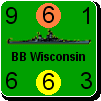warspite1
Posts: 41353
Joined: 2/2/2008
From: England
Status: offline

|
October 1939 (The North and South Atlantic – the surface raiders)
So we have covered the state of play for October as far as the U-boats are concerned, time to return to the Panzerschiffe. Having finally got permission from Berlin to commence operations, the Graf Spee opened her account with the sinking of the Clement on the 30th September (see Post 84). We shall start by following Graf Spee and then move on to Deutschland.
Having headed east, Graf Spee, by now sporting a rudimentary – but effective - disguise, was southeast of the Ascension Islands when she came across the 4,615 ton cargo vessel, Newton Beech (Captain Robinson). Robinson fell for the disguise (Graf Spee’s tower had been painted to look like a tripod and sported a French tricolour) and before a proper distress signal could be sent or secret papers destroyed, his ship was taken over. Stores of food were transferred from the Newton Beech and Langsdorff considered taking her as a prize.
Two days later Graf Spee intercepted the 4,200 ton Ashlea (Captain Pottinger). Again the disguise worked, and the merchant ship was boarded before a distress call was made, although at least her secret documents were destroyed. The crew of Ashlea was transferred to the Newton Beech and the Ashlea was sunk. Soon afterwards Langsdorff decided to sink Newton Beech too as her slow speed was causing him concern. The two merchant crews were taken on Graf Spee and the coup de grace delivered.
Travelling southwest, on the 10th October, Graf Spee’s next victim hove into view. She was the 8,300 ton cargo ship Huntsman (Captain Brown). Once again the Germans were able to capture important documents pertaining to British anti-raider precautions and codes. A prize crew transferred to Huntsman and she was ordered to sail to rendezvous with the Altmark, while Graf Spee hunted for her next victim.
The British were not convoying in the South Atlantic at this stage of the war and Graf Spee was reliant upon finding lone ships in the vast expanse of ocean. Her final success for the month did not come for another twelve days. Langsdorff in the meantime had another change of heart and, fearing the presence of large RN vessels (thanks to a large increase in wireless traffic) he decided to refuel from Altmark before making his next move. At the rendezvous all prisoners were transferred to Altmark and, after spending a few days transferring stores from Huntsman to both German ships, the British merchant ship was sunk. Time to move on.
Graf Spee was by now heading southeast and, on the 22nd October she came across the 5,300 ton Trevanion (Captain Edwards). Edwards ordered the distress signal be sent out and for confidential papers to be destroyed. 20mm rounds from the Panzerschiffe were meant to dissuade him of this notion, but Edwards refused to countermand the order and all vital documents were destroyed before the ship was overcome, the crew taken on board Graf Spee and Trevanion was sunk.
Graf Spee and Altmark met up again at the end of the month for further re-victualing, after which, Graf Spee headed southeast for the Indian Ocean.
While Langsdorff was dealing with Newton Beech on the 5th, Kapitan Wenneker was east of Bermuda intercepting the 5,044 ton merchant Stonegate (Captain Randall). A distress signal was sent, although this does not appear to have been picked up. The crew were removed, the British ship sunk and Deutschland then headed north.
Deutschland next came upon the 4,963 ton American merchant City of Flint. City of Flint had been one of the ships that come to the rescue of Athenia on the first day of the war. Wenneker believed that because she was carrying supplies for the UK he was justified in putting a prize crew aboard and ordered the ship to Murmansk (and thereafter to Germany). The US government protested strongly at this outrage and Hitler, still keen not to upset the US apple cart, ordered the ship be taken to neutral Norway instead. The Norwegians interned the prize crew and released the ship and her American crew to continue on to the UK.
Hitler was now concerned on two fronts. Firstly he was upset at the Norwegians (and no doubt seeds began to form in his mind that would ultimately lead to Weserubung (the invasion of Norway and Denmark)) and secondly he was concerned that Deutschland be sunk. Being superstitious, the idea that a ship bearing the name of the Fatherland be sunk horrified him. Hitler ordered Raeder to bring the Panzerschiff home.
Raeder did his best to “ignore” this order for as long as possible and on the 14th October, when 400 miles east of Newfoundland, Deutschland came across the 1,918 ton Norwegian vessel Lorentz W Hansen (Captain Hansen). By now, Raeder could not ignore his Fuhrer any longer and he ordered the Panzerschiffe to head back to Germany after what had been a thoroughly disappointing patrol.
The City of Flint. This neutral American vessel was involved in two episodes in the first few weeks of the war. She did not survive the war; she was torpedoed in the Atlantic in January 1943 by the U-boat U-575.

Next we will look at the Allied naval response to these German attacks.
Source:
The Real Cruel Sea (Richard Woodman)
The Price of Disobedience (Eric J Grove)
 Attachment (1) Attachment (1)
< Message edited by warspite1 -- 6/3/2015 8:11:44 PM >
_____________________________
England expects that every man will do his duty. Horatio Nelson October 1805  |
 Printable Version
Printable Version

 What source(s) are you using? You don't have to give it all away, just in general...thanks!
What source(s) are you using? You don't have to give it all away, just in general...thanks! 







 Don't you know your suppose to quit your day job and slavishly work at this thread and give us the absolutly most detail epic report of the naval war! Damit man, I want to know round counts and fuel usage!
Don't you know your suppose to quit your day job and slavishly work at this thread and give us the absolutly most detail epic report of the naval war! Damit man, I want to know round counts and fuel usage! 




















 New Messages
New Messages No New Messages
No New Messages Hot Topic w/ New Messages
Hot Topic w/ New Messages Hot Topic w/o New Messages
Hot Topic w/o New Messages Locked w/ New Messages
Locked w/ New Messages Locked w/o New Messages
Locked w/o New Messages Post New Thread
Post New Thread